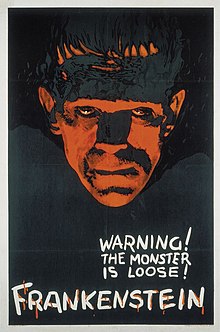
Abbott and Costello Meet Frankenstein is a 1948 American horror comedy film directed by Charles Barton. The film features Count Dracula who has become partners with Dr. Sandra Mornay, as Dracula requires a "simple, pliable" brain to reactivate Frankenstein's monster. Dracula discovers that the "ideal" brain belongs to Wilbur Grey who is wooed by Mornay to the operating table, despite the warnings of Lawrence Talbot.
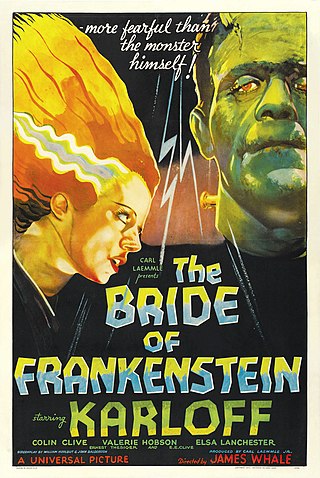
Bride of Frankenstein is a 1935 American science fiction horror film, and the first sequel to Universal Pictures' 1931 film Frankenstein. As with the first film, Bride of Frankenstein was directed by James Whale starring Boris Karloff as the Monster and Colin Clive as Dr. Frankenstein. The sequel features Elsa Lanchester in the dual role of Mary Shelley and the bride. Colin Clive reprises his role as Henry Frankenstein, and Ernest Thesiger plays the role of Doctor Septimus Pretorius. Oliver Peters Heggie plays the role of the old blind hermit.

Frankenstein is a 1931 American pre-Code science fiction horror film directed by James Whale, produced by Carl Laemmle Jr., and adapted from a 1927 play by Peggy Webling, which in turn was based on Mary Shelley's 1818 novel Frankenstein; or, The Modern Prometheus. The Webling play was adapted by John L. Balderston and the screenplay written by Francis Edward Faragoh and Garrett Fort, with uncredited contributions from Robert Florey and John Russell.
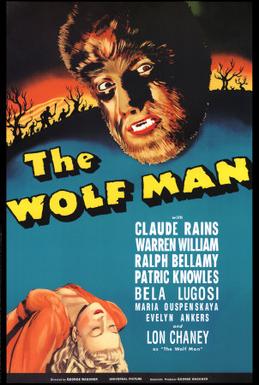
The Wolf Man is a 1941 American gothic horror film written by Curt Siodmak and produced and directed by George Waggner. The film stars Lon Chaney Jr. in the title role. Claude Rains, Warren William, Ralph Bellamy, Patric Knowles, Bela Lugosi, Evelyn Ankers, and Maria Ouspenskaya star in supporting roles. The title character has had a great deal of influence on Hollywood's depictions of the legend of the werewolf. The film is the second Universal Pictures werewolf film, preceded six years earlier by the less commercially successful Werewolf of London (1935). This film is part of the Universal Monsters movies and is of great cinematic acclaim for its production.

Dracula is a 1931 American pre-Code supernatural horror film directed and co-produced by Tod Browning from a screenplay written by Garrett Fort and starring Bela Lugosi in the title role. It is based on the 1924 stage play Dracula by Hamilton Deane and John L. Balderston, which in turn is adapted from the 1897 novel Dracula by Bram Stoker. Lugosi portrays Count Dracula, a vampire who emigrates from Transylvania to England and preys upon the blood of living victims, including a young man's fiancée.

Jack Pierce was a Hollywood make-up artist best remembered for creating the iconic makeup worn by Boris Karloff in Frankenstein (1931), along with various other classic monster make-ups for Universal Studios.
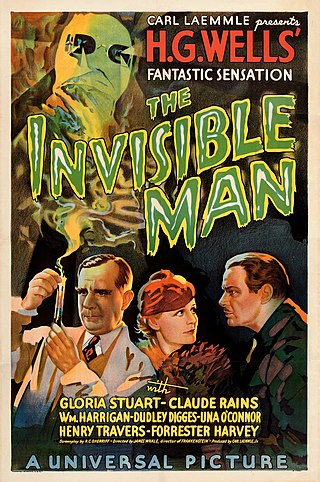
The Invisible Man is a 1933 American science fiction horror film directed by James Whale based on H. G. Wells' 1897 novel, The Invisible Man, produced by Universal Pictures, and starring Gloria Stuart, Claude Rains and William Harrigan. The film involves a Dr. Jack Griffin (Rains) who is covered in bandages and has his eyes obscured by dark glasses, the result of a secret experiment that makes him invisible, taking lodging in the village of Iping. Never leaving his quarters, the stranger demands that the staff leave him completely alone until his landlady and the villagers discover he is invisible. Griffin goes to the house of his colleague, Dr. Kemp and tells him of his plans to create a reign of terror. His fiancée Flora Cranley, the daughter of his employer Dr. Cranley, soon learn that Griffin's discovery has driven him insane, leading him to prove his superiority over other people by performing harmless pranks at first and eventually turning to murder.

Dracula's Daughter is a 1936 American vampire horror film produced by Universal Pictures as a sequel to the 1931 film Dracula. Directed by Lambert Hillyer from a screenplay by Garrett Fort, the film stars Otto Kruger, Gloria Holden in the title role, and Marguerite Churchill, and features, as the only cast member to return from the original, Edward Van Sloan – although his character's name was altered from "Van Helsing" to "Von Helsing".
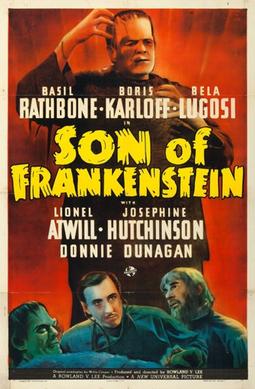
Son of Frankenstein is a 1939 American horror film directed by Rowland V. Lee and starring Basil Rathbone, Boris Karloff and Bela Lugosi. The film is the third in Universal Pictures' Frankenstein series and is the follow-up to the 1935 film Bride of Frankenstein. Son of Frankenstein stars Rathbone as Baron Wolf von Frankenstein who, with his wife Elsa and son Peter, returns to his late father's estate. Near the castle lives Ygor, a crazed blacksmith whose neck was broken in an unsuccessful hanging attempt. Among the castle's remains, Frankenstein discovers the remains of the Monster and decides to try to save his family name by resurrecting the creature to prove his father was correct. He finds, however, the Monster only responds to Ygor's commands.
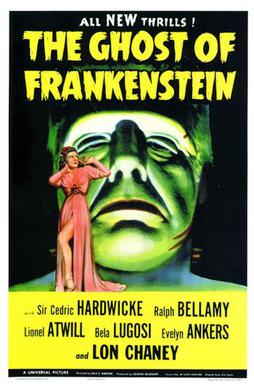
The Ghost of Frankenstein is a 1942 American horror film directed by Erle C. Kenton and starring Cedric Hardwicke, Lon Chaney Jr. and Bela Lugosi. It is the fourth film in the Frankenstein series by Universal Pictures, and the follow-up to Son of Frankenstein (1939). The film's plot follows the previous film's: Frankenstein's Monster and his companion Ygor are chased out of town. They go to another small town to encourage the younger son of Henry Frankenstein to continue his father's experiments, so that Ygor can have revenge against his enemies and his brain transplanted into the Monster's skull.

Frankenstein Meets the Wolf Man is a 1943 American horror film directed by Roy William Neill and starring Lon Chaney Jr. as the Wolf Man and Bela Lugosi as Frankenstein's monster. This was the first of a series of later called "monster rallies" combining characters from several film series. This film's script written by Curt Siodmak follows The Ghost of Frankenstein and The Wolf Man. The film involves Larry Talbot who is brought back to life. Seeking a way to return to his death to escape his werewolf curse, he meets with gypsy Maleva who advises him that the only way to stay dead is to confer with Dr. Frankenstein. The doctor is long dead but his equipment is in working condition, leading Talbot to seek the help of scientist Dr. Mannering and Frankenstein descendant Baroness Elsa Frankenstein. Talbot then attempts to have his life sucked from his body and transferred into Frankenstein's monster.

Son of Dracula is a 1943 American horror film directed by Robert Siodmak with a screenplay based on an original story by his brother Curt Siodmak. The film stars Lon Chaney Jr., Louise Allbritton, Robert Paige, Evelyn Ankers, and Frank Craven. The film is set in the United States, where Count Alucard has just taken up residence. Katherine Caldwell (Allbritton), a student of the occult, becomes fascinated by Alucard and eventually marries him. Katherine begins to look and act strangely, leading her former romantic partner Frank Stanley (Paige) to suspect that something has happened to her. He gets help from Dr. Brewster (Craven) and psychologist Laszlo who come to the conclusion that Alucard is a vampire.

House of Frankenstein is a 1944 American horror film starring Boris Karloff, Lon Chaney Jr. and John Carradine. Based on a story by Curt Siodmak, it was directed by Erle C. Kenton and produced by Universal Pictures.

House of Dracula is a 1945 American horror film released and distributed by Universal Pictures. Directed by Erle C. Kenton, the film features several Universal Horror properties meeting as they had done in the 1944 film House of Frankenstein. The film is set at the castle home of Dr. Franz Edelmann, who is visited first by Count Dracula and later by Larry Talbot, the Wolf Man, who are trying to cure their vampirism and lycanthropy, respectively. Talbot is eventually cured, which leads him to discover the body of Frankenstein's monster in a cave below the base of the castle. Edelemann takes the monster's body back to his laboratory but finds Count Dracula has awakened and by attacking his assistants, he captures Edelmann and forces a reverse blood transfusion, which gives Edelmann a split personality and makes him a killer.

Universal Classic Monsters is a home video line based on a series of horror films primarily produced by Universal Pictures from the 1930s to the 1950s. Although not initially conceived as a franchise, the enduring popularity and legacy of the films and the characters featured in them has led the studio to market them under the collective brand name of Universal Studios Monsters. Steve Jones of USA Today described Universal's most famous monsters as "pop culture icons", specifically Dracula, Frankenstein, the Mummy, and the Wolf Man.

Murders in the Rue Morgue is a 1932 American horror film directed by Robert Florey, based on Edgar Allan Poe's 1841 short story "The Murders in the Rue Morgue". The plot is about Doctor Mirakle, a carnival sideshow entertainer and scientist who kidnaps Parisian women to mix their blood with that of his gorilla, Erik. As his experiments fail because of the quality of his victims' blood, Mirakle meets with Camille L'Espanye, and has her kidnapped and her mother murdered, leading to suspicion falling on Camille's fiance, Pierre Dupin, a medical student who has already become interested in the earlier murders.
Shock Theater is a package of 52 pre-1948 classic horror films from Universal Studios released for television syndication in October 1957 by Screen Gems, the television subsidiary of Columbia Pictures. The Shock Theater package included Dracula, Frankenstein, The Mummy, The Invisible Man and The Wolf Man as well as a few non-horror spy and mystery films. A second package, Son of Shock, was released for television by Screen Gems in 1958, with 20 horror films from both Universal and Columbia.
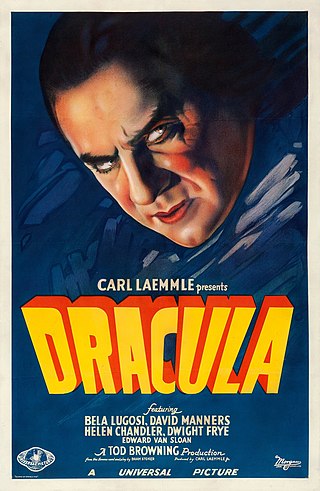
Dracula is a film series of horror films from Universal Pictures based on the 1897 novel Dracula by Bram Stoker and its 1927 play adaptation. The series is a loose collection of films, with historians stating that the films all reference characters, events or at least passing knowledge of the 1931 English-language production of Dracula, with historians noting that Dracula's Daughter and Son of Dracula are more closely related to the 1931 film while the character of Dracula would make smaller appearances in later films such as House of Frankenstein and House of Dracula. After Dracula's Daughter, the character of Dracula and other vampires in the series became more Americanized, starting with the release of Son of Dracula, and the later House of films. The character of Dracula appears in all the films outside of Dracula's Daughter, where he is portrayed by Bela Lugosi, Lon Chaney Jr., and John Carradine in the House of films.
The Wolf Man is the title of several horror film series centered on Larry Talbot, a man who upon being bitten by a werewolf becomes one himself, and his subsequent attempts to cure himself of his murderous condition. The franchise was created by Curt Siodmak.

The history of horror films was described by author Siegbert Solomon Prawer as difficult to read as a linear historical path, with the genre changing throughout the decades, based on the state of cinema, audience tastes and contemporary world events.
